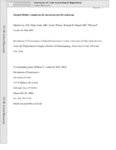|
|
Creator | Title | Description | Subject | Date |
| 26 |
 |
Couldwell, William T. | Surgical fidelity: comparing the microscope and the endoscope | Background: Both the microscope and the endoscope are widely used as visualization tools in neurosurgery; however, surgical dexterity when operating with endoscopic visual control may differ. The aim of this study was to compare the surgical fidelity when using each of these visualization tools. Met... | | 2013-01-01 |
| 27 |
 |
Couldwell, William T. | Resident curriculum guidelines for neurosurgery | This curriculum was created to detail the body of knowledge that should be attained by an individual completing residency training in neurological surgery. The specific structure of resident education in neurological surgery is defined by the American Board of Neurological Surgery, and each program... | Residency training; Neurological surgery | 2000 |
| 28 |
 |
Couldwell, William T. | Management of pituitary adenomas | We present an overview of the management of pituitary adenomas, with discussions of microanatomy, of diagnostic studies of general neuroendocrine function, and of radiologic evaluation. We discuss the diagnosis of pituitary adenoma and its treatment with sections on null cell, prolactin (PRL)-secre... | Pituitary adenoma; Transsphenoidal surgery; Corticotropin; Prolactin; Growth hormone; Transcranial surgery | 1994 |
| 29 |
 |
Normann, Richard A.; Branner, Almut | Long-term stimulation and recording with a penetrating microelectrode array in cat sciatic nerve | We studied the consequences of long-term implantation of a penetrating microelectrode array in peripheral nerve over the time course of 4-6 mo. Electrode arrays without lead wires were implanted to test the ability of different containment systems to protect the array and nerve during contractions o... | Cats; Microelectrodes; Prosthesis Implantation; Sciatic Nerve | 2004 |
| 30 |
 |
Lucero, Mary T.; Mobley, Arie S. | Cross-species comparison of metabolite profiles in chemosensory epithelia: an indication of metabolite roles in chemosensory cells | Comparative studies of chemosensory systems in vertebrates and invertebrates have greatly enhanced our understanding of anatomical and physiological constraints of chemical detection. Immunohistochemical comparisons of chemosensory systems are difficult to make across species due to limited cross-re... | Olfactory; Vomeronasal; Mouse; Zebrafish; Squid | 2008-04 |
| 31 |
 |
Dailey, Andrew T. | Pathophysiology of oral pharyngeal apraxia and mutism following posterior fossa tumor resection in children | Mutism following posterior fossa tumor resection in pediatric patients has been previously recognized, although its pathophysiology remains unclear. A review of the available literature reveals 33 individuals with this condition, with only a few adults documented in the population. All of these pati... | Vermis; Posterior fossa tumor; Pediatric patients | 1995 |
| 32 |
 |
Couldwell, William T. | Utilization of unilateral and bilateral stereotactically placed adrenomedullary-striatal autografts in Parkinsonian humans: rationale, techniques, and observations | A limited clinical pilot study involving an amalgam of specialized disciplines including neurology, neuropharmacology, neuropsychology, neurosurgery, neuroanesthesia, neuroradiology, surgical pathology, neuropathology, and urological surgery was organized to clarify issues related to patient selecti... | Adrenal medullary graft; Autograft; Brain graft; Neural transplantation; Parkinsonism; Stereotaxy | 1990 |
| 33 |
 |
Baehr, Wolfgang | Calcium-sensitive particulate guanylyl cyclase as a modulator of cAMP in olfactory receptor neurons | The second messengers cAMP and inositol-1,4,5-triphosphate have been implicated in olfaction in various species. The odorant-induced cGMP response was investigated using cilia preparations and olfactory primary cultures. Odorants cause a delayed and sustained elevation of cGMP. A component of this c... | Calcium-Binding Proteins; Nerve Tissue Proteins; Rats, Sprague-Dawley | 1998 |
| 34 |
 |
Dailey, Andrew T. | Surgical treatment of occipitocervical instability | OBJECTIVE: Instability of the occipitocervical junction can be a challenging surgical problem because of the unique anatomic and biomechanical characteristics of this region. We review the causes of instability and the development of surgical techniques to stabilize the occipitocervical junction. ... | Occipitocervical instability | 2008 |









